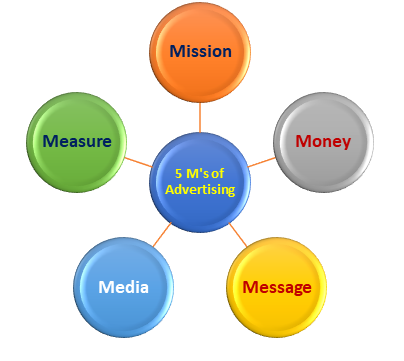The 5 M’s of advertising are as follows:
- Mission
- Money
- Message
- Media
- Measurement

-
Mission:
Advertising Objectives can be classified as to whether their aim is:
- To inform: This aim of Advertising is generally true during the pioneering stage of a product category, where the objective is building a primary demand.
- To persuade: Most advertisements are made with the aim of persuasion. Such advertisements aim at building selective brand.
- To remind: Such advertisements are highly effective in the maturity stage of the product. The aim is to keep the consumer thinking about the product.
-
Money:
This M deals with deciding on the Advertising Budget
The advertising budget can be allocated based on:
- Departments or product groups
- The calendar
- Media used
- Specific geographic market areas
There are five specific factors to be considered when setting the Advertising budget.
- Stage in PLC: New products typically receive large advertising budgets to build awareness and to gain consumer trial. Established brands are usually supported with lower advertising budgets as a ratio to sales.
- Market Share and Consumer base: high-market-share brands usually require less advertising expenditure as a percentage of sales to maintain their share. To build share by increasing market size requires larger advertising expenditures. Additionally, on a cost-per-impressions basis, it is less expensive to reach consumers of a widely used brand them to reach consumers of low-share brands.
- Competition and clutter: In a market with a large number of competitors and high advertising spending, a brand must advertise more heavily to be heard above the noise in the market. Even simple clutter from advertisements not directly competitive to the brand creates the need for heavier advertising.
- Advertising frequency: the number of repetitions needed to put across the brands message to consumers has an important impact on the advertising budget.
Product substitutability: brands in the commodity class (example cigarettes, beer, soft drinks) require heavy advertising to establish a different image. Advertising is also important when a brand can offer unique physical benefits or features.
-
Message:
Message generation can be done in the following ways:
- Inductive: By talking to consumers, dealers, experts and competitors. Consumers are the major source of good ideas. Their feeling about the product, its strengths, and weaknesses gives enough information that could aid the Message generation process.
- Deductive: John C. Meloney proposed a framework for generating Advertising Messages.
According to him, a buyer expects four types of rewards from a product:
- Rational
- Sensory
- Social
- Ego Satisfaction.
Buyers might visualize these rewards from:
- Results-of-use Experience
- Product-in-use Experience
- Incidental-to-use Experience
-
Media:
The next M to be considered while making an Advertisement Program is the Media through which to communicate the Message generated during the previous stage. The steps to be considered are:
-
Measurement:
Evaluating the effectiveness of the Advertisement Program is very important as it helps prevent further wastage of money and helps make corrections that are important for further advertisement campaigns. Researching the effectiveness of the advertisement is the most used method of evaluating the effectiveness of the Advertisement Program. Research can be in the form of:
- Communication-Effect Research
- Sales-Effect Research